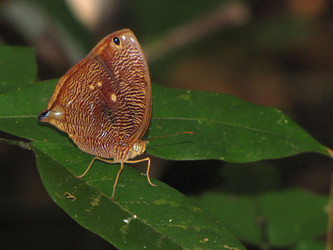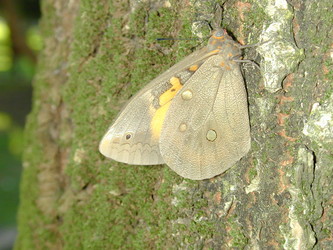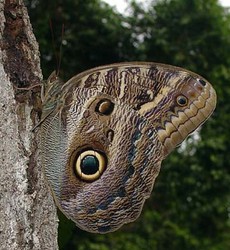Brassolini
Niklas Wahlberg and Andrew V. Z. Brower


This tree diagram shows the relationships between several groups of organisms.
The root of the current tree connects the organisms featured in this tree to their containing group and the rest of the Tree of Life. The basal branching point in the tree represents the ancestor of the other groups in the tree. This ancestor diversified over time into several descendent subgroups, which are represented as internal nodes and terminal taxa to the right.

You can click on the root to travel down the Tree of Life all the way to the root of all Life, and you can click on the names of descendent subgroups to travel up the Tree of Life all the way to individual species.
For more information on ToL tree formatting, please see Interpreting the Tree or Classification. To learn more about phylogenetic trees, please visit our Phylogenetic Biology pages.
close boxIntroduction
The Brassolini are a neotropical tribe which includes the very large "owl butterflies" (Caligo), as well as a number of other striking species. Many of them are crepuscular, exhibiting rapid flight that almost makes them look like bats. The larvae of brassolines feed on monocots, and some species are pests of palms. Many of the genera are endemic to the Atlantic coastal forests of southeastern Brazil.
Discussion of Phylogenetic Relationships
Phylogenetic relationships among genera are shown based on the phylgoenetic analysis of morphological characters by Penz (2007).References
Casagrande MM. 1995. Notas sistemáticas sobre Brassolinae. I. Tribos (Lepdoptera, Nymphalidae). Revta. Bras. Zool. 12: 671-699.
Casagrande, MM. 2004. Brassolini. In Lamas G ed. 2004. Atlas of Neotropical Lepidoptera. Checklist: Part 4A Hesperioidea - Papiionoidea. Gainesville: Scientific Publishers/Association of Tropical Lepidoptera.
Penz, C. M. 2007 Evaluating the monophyly and phylogenetic relationships of Brassolini genera (Lepipoptera, Nymphalidae). Syst. Ent. 32, 668-689.
Title Illustrations

| Scientific Name | Bia actorion |
|---|---|
| Location | Rio Urubu, Amazonas, Brazil |
| Specimen Condition | Live Specimen |
| Source | Bia Owl |
| Source Collection | Flickr |
| Image Use |
 This media file is licensed under the Creative Commons Attribution-NonCommercial License - Version 3.0. This media file is licensed under the Creative Commons Attribution-NonCommercial License - Version 3.0.
|
| Copyright |
© 2010

|
| Scientific Name | Brassolis astyra Godart |
|---|---|
| Location | Campinas, Brasil |
| Specimen Condition | Live Specimen |
| Identified By | Andrew V. Z. Brower |
| Life Cycle Stage | adult |
| Image Use |
 This media file is licensed under the Creative Commons Attribution-NonCommercial License - Version 3.0. This media file is licensed under the Creative Commons Attribution-NonCommercial License - Version 3.0.
|
| Copyright |
©

|
| Scientific Name | Caligo illioneus |
|---|---|
| Location | Brazil: Mato Grosso, Cristalino Lodge |
| Specimen Condition | Live Specimen |
| Identified By | Will Carter |
| Life Cycle Stage | adults |
| View | ventral |
| Source | Illioneus Giant Owl (Caligo illioneus) |
| Source Collection | Neotropical Butterflies |
| Copyright | © 2004 Will Carter |
About This Page
Niklas Wahlberg

University of Turku, Finland

Middle Tennessee State University, Murfreesboro, Tennessee, USA
Correspondence regarding this page should be directed to Niklas Wahlberg at and Andrew V. Z. Brower at
Page copyright © 2010 Niklas Wahlberg and
 Page: Tree of Life
Brassolini .
Authored by
Niklas Wahlberg and Andrew V. Z. Brower.
The TEXT of this page is licensed under the
Creative Commons Attribution License - Version 3.0. Note that images and other media
featured on this page are each governed by their own license, and they may or may not be available
for reuse. Click on an image or a media link to access the media data window, which provides the
relevant licensing information. For the general terms and conditions of ToL material reuse and
redistribution, please see the Tree of Life Copyright
Policies.
Page: Tree of Life
Brassolini .
Authored by
Niklas Wahlberg and Andrew V. Z. Brower.
The TEXT of this page is licensed under the
Creative Commons Attribution License - Version 3.0. Note that images and other media
featured on this page are each governed by their own license, and they may or may not be available
for reuse. Click on an image or a media link to access the media data window, which provides the
relevant licensing information. For the general terms and conditions of ToL material reuse and
redistribution, please see the Tree of Life Copyright
Policies.
- First online 25 September 2006
- Content changed 13 February 2010
Citing this page:
Wahlberg, Niklas and Andrew V. Z. Brower. 2010. Brassolini . Version 13 February 2010 (under construction). http://tolweb.org/Brassolini/70271/2010.02.13 in The Tree of Life Web Project, http://tolweb.org/











 Go to quick links
Go to quick search
Go to navigation for this section of the ToL site
Go to detailed links for the ToL site
Go to quick links
Go to quick search
Go to navigation for this section of the ToL site
Go to detailed links for the ToL site